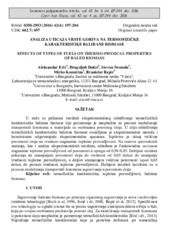Приказ основних података о документу
Analiza uticaja vrste goriva na termofizičke karakteristike balirane biomase
Effects of types of fuels on thermo-physical properties of baled biomass
| dc.creator | Erić, Aleksandar | |
| dc.creator | Dakić, Dragoljub | |
| dc.creator | Nemoda, Stevan | |
| dc.creator | Komatina, Mirko | |
| dc.creator | Repić, Branislav | |
| dc.date.accessioned | 2022-09-19T17:50:18Z | |
| dc.date.available | 2022-09-19T17:50:18Z | |
| dc.date.issued | 2016 | |
| dc.identifier.issn | 0350-2953 | |
| dc.identifier.uri | https://machinery.mas.bg.ac.rs/handle/123456789/2273 | |
| dc.description.abstract | U radu su prikazani rezultati eksperimentalnog određivanja termofizičkih karakteristika balirane biomase čije poznavanje je neophodno za procese modeliranja transportnih fenomena u materijalu sa osobinama poroznog sloja. U cilju određivanja termofizičkih karakteristika balirane biomase osmišljena je eksperimentalna metoda i konstruisana odgovarajuća eksperimentalna aparatura. Ispitivan je uticaj veličine poroznosti sloja na vrednost stagnantne toplotne provodljivosti. Na osnovu sprovedenih merenja, kao i analize eksperimentalnih rezultata, određena je funkcionalna zavisnost stagnantne toplotne provodljivosti od poroznosti u opsegu od 0,50-0,85. Dobijeni rezultati pokazuju da smanjenjem poroznosti sloja do vrednosti od 0,65 dolazi do smanjenja vrednosti toplotne provodljivosti, a daljim smanjenjem veličine poroznosti ispod 0,65 dolazi do porasta vrednosti toplotne provodljivosti. Dobijeni rezultati korišćeni su u procesu modeliranja transportnih fenomena sagorevanja u poroznom sloju. | sr |
| dc.description.abstract | The paper presents experimental data obtained in the course of investigation focused on analysis of thermo-physical properties of baled biomass which value are necessary for modeling of transport phenomena in materials with porous bed. Experiments were conducted using a custom designed and constructed experimental setup and implementing original experimental procedure. Results obtained enabled stagnant thermal conductivity of biomass to be determined for different biomass porosity values. Analysis of experimental data enabled functional dependence of stagnant thermal conductivity on porosity to be determined, with porosity varied in a range 0.50-0.85. Results obtained indicate that reduced bed porosity, down to the value of 0.65, causes stagnant thermal conductivity of the bed to be reduced. Further porosity reduction, below the value of 0.65, results in increased stagnant thermal conductivity of the bed. In addition, data to be acquired shall be helpful in modeling the transport phenomena associated with combustion in porous beds. | en |
| dc.publisher | Nacionalno naučno društvo za poljoprivrednu tehniku, Novi Sad | |
| dc.relation | info:eu-repo/grantAgreement/MESTD/Integrated and Interdisciplinary Research (IIR or III)/42011/RS// | |
| dc.rights | openAccess | |
| dc.rights.uri | https://creativecommons.org/licenses/by-sa/4.0/ | |
| dc.source | Savremena poljoprivredna tehnika | |
| dc.subject | toplotna provodljivost | sr |
| dc.subject | termofizičke karakteristike | sr |
| dc.subject | balirana biomasa | sr |
| dc.subject | Thermo-physical characteristics | en |
| dc.subject | thermal conductivity | en |
| dc.subject | baled biomass | en |
| dc.title | Analiza uticaja vrste goriva na termofizičke karakteristike balirane biomase | sr |
| dc.title | Effects of types of fuels on thermo-physical properties of baled biomass | en |
| dc.type | article | |
| dc.rights.license | BY-SA | |
| dc.citation.epage | 206 | |
| dc.citation.issue | 4 | |
| dc.citation.other | 42(4): 197-206 | |
| dc.citation.rank | M52 | |
| dc.citation.spage | 197 | |
| dc.citation.volume | 42 | |
| dc.identifier.doi | 10.5937/SavPoljTeh1604197E | |
| dc.identifier.fulltext | http://machinery.mas.bg.ac.rs/bitstream/id/1027/2270.pdf | |
| dc.type.version | publishedVersion |


